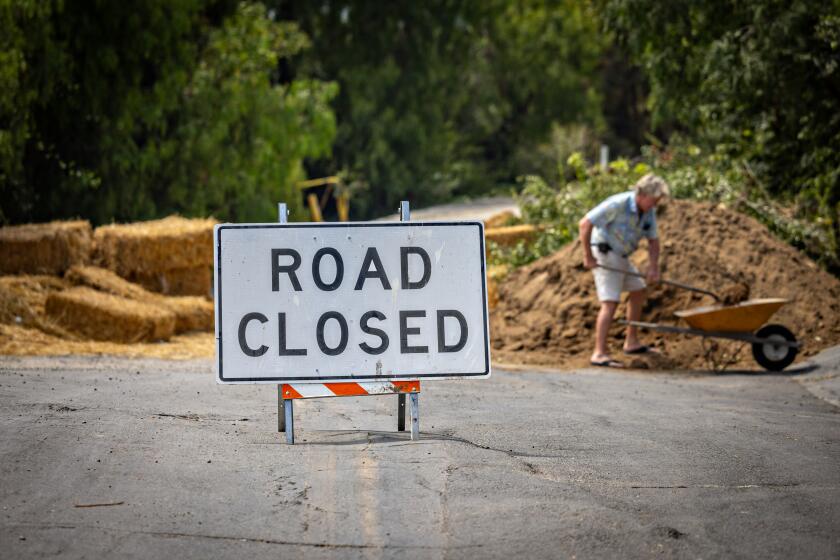Thinking of borrowing? Low mortgage rates may be poised to rise
If you’re borrowing to buy a house, there’s almost never been a better time to do it.
Interest rates on an average 30-year fixed-rate mortgage hit 4.1% this week, a low for the year, according to lending giant Freddie Mac.
They’ve been bouncing in the low 4% range for months, not quite record territory but not far from it. It’s helping to ease the pain of home prices that have climbed by one-third in Southern California over the last two years.
But at some point — and fairly soon, forecasters say — these cheap money days will end. When they do, the stop-and-start housing recovery could face the kind of hurdle it hasn’t seen in a long time.
Low rates have propped up the housing market for years now. But with the Federal Reserve ending its so-called “quantitative easing” program to lower rates and the economy gradually strengthening, many market watchers are predicting rates will start to rise again soon. This time next year, the Mortgage Bankers Assn. projects, the average interest rate on a 30-year fixed-rate mortgage will be 5.2%, its highest level since early 2010.
That jump will come at a price.
At today’s 4.1% rate, the monthly payment on a 30-year fixed-rate mortgage with 20% down at Los Angeles County’s median price of $457,500 would be $1,768, according to Bankrate.com’s mortgage calculator. Add a point and the monthly payment climbs to $2,009.
That extra $241 a month is no small thing for a housing market that’s already struggling with affordability issues, said Leslie Appleton-Young, chief economist at the California Assn. of Realtors.
“It’s going to worsen affordability,” she said. “All else remaining the same, higher rates are going to make it more difficult for people to get into housing.”
And coming after years of low rates — when many homeowners either bought a house with a relatively cheap mortgage or refinanced into one — rate hikes could also squeeze supply, which is already fairly tight by historical standards.
Roughly half of the nation’s 50 million home mortgages have interest rates at or below the current rates, said Mark Fleming, chief economist at real estate data firm CoreLogic. So if rates go up, buying anew would mean a more costly mortgage.
“That means you don’t have a lot of incentive to sell your home,” he said. “That could lead to a lack of supply going forward.”
It would be the reverse of a broader trend the housing market has enjoyed for 30 years now, Fleming notes, a period when interest rates have moved generally downward from 18% in the early 1980s to as low as 3% early last year. In that time, he said, tens of millions of people have been able to sell a house and buy a new one at a cheaper interest rate, essentially getting more house for the same money. If rates start trending upward, that will flip.
“That’s what’s going to be different,” Fleming said.
Not that homeowners couldn’t benefit in other ways. Tight supply could well boost prices, Fleming notes, which could be a bigger incentive to sell than the higher rates are a deterrent to buy. If rates rise quickly, it’s likely a sign of inflation and wage growth, which could help more people afford a house. And people will buy and sell houses for all the non-financial reasons they always have, from growing families to new jobs to simply wanting to move.
“Will it be more difficult? Yes. Will people buy a smaller home? Maybe,” Fleming said. “But we expect there’s going to be a black-and-white answer, and market forces don’t always work that way.”
Indeed, when rates start to rise, there may well be a flurry of sales as buyers rush to lock in lower payments while they still can, said Mark Goldman, a mortgage broker who teaches real estate at San Diego State University.
In the long run, Goldman and other market watchers say, higher rates may help to damp home sales, which are already running well below historical averages. But they’ll be balanced out by clearer lending guidelines and slightly looser credit requirements. And mostly, Goldman said, they’ll be taking place in a market that — after years of booms and busts — appears to be behaving somewhat normally.
“We’re in a period of extraordinary equilibrium right now,” he said. “Don’t panic.”
Twitter: @bytimlogan
More to Read
Sign up for Essential California
The most important California stories and recommendations in your inbox every morning.
You may occasionally receive promotional content from the Los Angeles Times.







